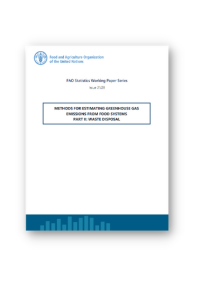Methods for estimating greenhouse gas emissions from food systems
01/12/2021
.png?sfvrsn=d99cca42_1)
This series of paper detail new methodologies for estimating key components of agri-food systems emissions. They focus on GHG emissions associated with historic and current domestic food transport, waste disposal and energy use in fertilizer manufacturing, food processing, packaging, retail and household consumption.
Our efforts help to better characterize food systems and the role they can play in achieving the Sustainable Development Goals. In particular, they align well with Goal 12 to ensure “sustainable consumption and production patterns’’, specifically Target 12.2, “achieve the sustainable management and efficient use of natural resources” and Indicator 12.2.1, which monitors the “material footprint, material footprint per capita, and material footprint per GDP” of different products.

Part 1: Domestic food transport
This paper provides a methodology for estimating the GHG emissions associated with historic and current domestic food transport, in an effort to inform countries of the environmental impact of their food distribution systems.

This paper provides a methodology for estimating the GHG emissions associated with emissions from waste in the food system (e.g., food-related processes in landfills, incineration, wastewater management processes), in an effort to inform countries of the environmental impacts and possible options to reduce them.

This paper describes methods for estimating greenhouse gas (GHG) emissions from fossil fuel-based energy use in agri-food systems processes outside agricultural land, i.e. those associated with pre- and post-production activities – in an effort to inform countries of the environmental impacts of agri-food systems and the possible options to reduce them.
.png?sfvrsn=6452f9de_1)
Part 4: Pesticides manufacturing
This paper describes methods for estimating greenhouse gas (GHG) emissions associated with historic and current pesticide manufacturing, as part of an overall aim to inform countries of the environmental impacts of agrifood systems and the possible options to reduce them.
.png?sfvrsn=7f7857c6_1)
Part 5: Household food consumption
This paper describes methods for estimating greenhouse gas (GHG) emissions in households, which include fossil fuel-based energy use and non-renewable (i.e. beyond sustainable wood harvesting levels) woodfuel use.
Part 6: Fluorinated gas emissions
This paper describes methods for estimating greenhouse gas (GHG) emissions from the agrifood system, and in particular fluorinated gases (F-gases) from refrigeration systems in the food system cold chain, from food processing to food transport, retailing and household consumption processes. Based on the proposed methodology, we build a new database of GHG from F-gases used in the agrifood system, by country and with global coverage, for the period 1990–2021.
Working towards SDGs:
![]()
![]()

.png?sfvrsn=f3f6c793_1)